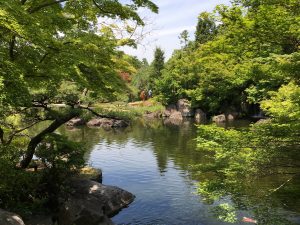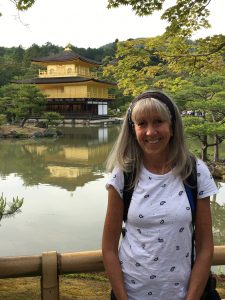Another day trip out of Kyoto about 100 miles to Himeji to see the Castle there. Known as the White Heron Castle (as an opposite to the black castle in Masumoto), it is a UNESCO World Heritage Site, and well worth the hour on the bullet train to get there. It is called the heron castle because its graceful outlines and white plaster walls resemble a bird taking flight. Build on a hill in the middle of a vast plain, it is an impregnable fortress and is a model of the art of defense: a labyrinth of moats, ditches and traps, as well as fan-shaped parapets and passages leading to nowhere were all designed to keep attackers at bay. It has undergone several restorations over the centuries, with the most recent one completed in 2015.
Built in 1346, it was seized in 1577 by Toyotomi Hideyoshi who enlarged it to make it a strategic fortress. It passed along a number of clans adding buildings and turrets, but many of the most compelling stories are about the time Princess Sen lived there. She was the granddaughter of the first Tokugawa shogun, and after her first husband died she married Honda Tadatoki, whose father had been appointed lord of the Himeji Castle. They had two children, but her son died at the age of 3, and it is said she had a shrine built on the hill behind the castle to pray for the soul of her son, and for her husband who also died at a young age. She then returned to Edo and became a nun, spending the rest of her life in mourning.
There are many fascinating architectural notes, including the shachi, the ornament typically mounted at the ends of the tiled roof ridge. It is a representation of a mythical creature resembling a fish with the head of a tiger, a raised tail and rows of sharp fins along its back. It is regarded as a guardian deity. It was a beautiful sight — an enormous building, obviously well cared for as a national treasure. It has appeared in several films, including Kurosawa’s Ran, and one of the 007 flicks. The nearby garden, called Koko-en was a beautiful space of 9 different gardens, many of which had a lovely view of the castle.
Then it was back to the bullet train and into Kyoto, and onto a bus to get to the Golden Pavilion — our last chance to see this World Heritage Site before we leave Kyoto. Built by Yoshimitsu, the 3rd shogun of the Ashikaga dynasty in the 14thC, he built it after he relinquished power and became a monk under the name Rokuon. The name, Kikaku-ji derives from the fact that the two upper stories are clad in gold leaf. It now serves for meditation on the first floor, and houses Buddhist relics above. So it’s mainly a beautiful structure to see from the other side of the pond, and hopefully capture it’s reflection in it. Yoshimitsu was a great devotee of Zen philosophy, so it’s not surprising that his pavilion was converted into a temple after his death. It was a striking structure.
Exhausted from the heat and the walking around castles, we made our way to another bus and back to the neighborhood, stopping at a spot for ramen and gyoza that Liz and Jonathan had recommended and which quickly gained a line of people, so it must have been a hot ticket. We got in early, and out early, and ended the day. It will be a day of travel tomorrow, so lots to do to get organized after a week in Kyoto.












Beautiful! The scenery too!